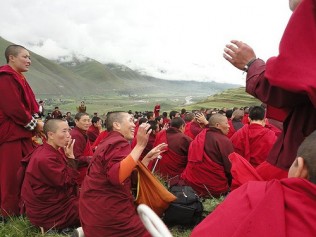Across Tibet, monks, nuns, students, and others are protesting China’s continuing control of the region—many in a gruesome and tragic way. Ninety-five Tibetans have set themselves ablaze since March 16, 2011 – 33 of them in the last two months of 2012 alone. Nearly all have called for Tibetan freedom, the relaxation of religious and cultural policies, and the return of the Dalai Lama, Tibet’s exiled spiritual leader.
According to Human Rights Watch, these self-immolations highlight the failure of Chinese authorities to address Tibetan grievances. The Dalai Lama himself has acknowledged the protests as a response to the desperate conditions Tibetans face under Beijing control, stating at a news conference in late 2011 that “some kind of cultural genocide is taking place.” China recently banned human rights monitors from entering Tibet, also barring foreign journalists and others from traveling to certain regions of the country.
During the 1950s, the Chinese government enforced, through military occupation, a long-held claim on Tibet. From 1963 until 1971, during the establishment of the Tibetan Autonomous Region (TAR) and the Cultural Revolution, foreign visitors were banned from Tibet. Since that time, particularly with the introduction of China’s “Open Door” reform policy, the drive toward modernization has made tourism in Tibet both desirable and more accessible. The China Daily reports that the TAR received a record 10 million domestic and foreign tourists in 2012 through November 30, showing a 33.9 percent increase in revenue in the tourism sector.

For many travelers, the question of whether or not to visit a country controlled by a regime with a record of human rights abuses, such as Chinese-occupied Tibet, has long been laden with ethical and moral dilemmas. The answer is rarely simple and those who decide to travel are likely to encounter cultural clashes and diverging perspectives. While many people both inside and outside Tibet remain strongly opposed to China’s presence and policies, Chinese leaders argue that their investments have brought economic benefits to Tibetans, with increased modern amenities and infrastructure, including improvements to roads, schools and hospitals.
One thing there seems to be little disagreement about is that the Himalayan plateau has been experiencing rapid development. Photographer Marieke ten Wolde has been photographing this transformation for the last decade. She told the New York Times, “Sometimes it’s very sad, because the beautiful things disappear, and sometimes they’re good things. But it’s always changing. Each time I return it’s like I’m going back to a different century.”
While travelers to Tibet will undoubtedly see evidence of the shift away from traditional lifestyles and the influx of Han Chinese settlers, the extent to which the Tibetan population is experiencing deepening religious and cultural repression may not be as apparent to an outsider. “From the outside, everything looks so pretty here, but on the inside, everyone is boiling,” a lama at a monastery in Rebkong, known for its elaborate thangka paintings, said in an interview with the New York Times. Asking for anonymity since talking to foreign reporters can lead to severe punishment, he added, speaking of the monks, “I don’t want trouble with the authorities, but I can’t control their rage any longer.” A recent National Geographic News article reports that repressive activities include the installation of security cameras in monasteries, the destruction of portraits of the Dalai Lama, the forced settling of nomads, and the marginalization of the Tibetan language.

Traveling to Tibet under the current regime has many implications for foreign tourists. Practically speaking, the shifting political responses to the immolations and protests have resulted in area closures to foreigners, unexpected delays in obtaining visas and permits, and an increased military presence on the ground. But for those choosing to steer through the paperwork and unpredictability, preparing to travel conscientiously may mean addressing the following common concerns:
Does tourism provide legitimacy to an occupation and encourage oppression?
Geographic Expeditions (GeoEx), a pioneer in travel to Tibet, sees some truth to this concern on a strict dollars-and-cents basis. However, the company has given this issue extensive consideration, to the point of drafting an official policy document addressing whether travelers should be encouraged to visit countries with despotic governments. GeoEx concludes that they should, because “[d]espotic regimes work best in secrecy and in isolation from the world.”
Toni Neubauer, president of Myths and Mountains, another leader in Himalayan travel, feels that tourism in Tibet, when done well, is a critical link for the Tibetan people to the outside world. Referring to the figures noted earlier from the China Daily, Neubauer surmises that the increase in tourism revenue in 2012 – despite the closing of Tibet to foreign travelers for much of the summer – was due to an influx of Chinese tourists, a trend that is likely to continue.
GeoEx has asked Tibetans directly: Would it be better if the Chinese were the only foreigners in Tibet? The answer has been a resounding “no.” As reinforcement, the company’s policy document shares the view of John Healey, former executive director of Amnesty International USA: “We’re aware that human contact is one of the most powerful weapons against abuse. Renegade governments often clean up their act when they know the outside world is watching. Victims of oppression crave contact.”
Will most of the tourism dollars just go to enterprises supported by an oppressive regime?
Read Ethical Traveler's Reprint Policy.
